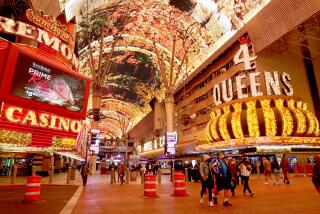It’s a problem. But a disorder?
There is little doubt that compulsive shopping can cause severe impairment and distress -- two key criteria for formal recognition as a mental disorder.
But the rest remains up for grabs: Is compulsive shopping a biologically driven disease of the brain, a learned habit run amok, an addiction in its own right, or a symptom of the other dysfunctions -- most notably depression -- that so often accompany it? Where is the line between avid shopping (a norm widely observed in the United States) and compulsive shopping? And how, if this is an illness, is it best treated?
Compulsive buying is not currently recognized as a disorder by the mental health profession’s guidebook, the Diagnostic and Statistical Manual of Mental Disorders, generally called the DSM. That may change soon, as psychiatrists draft the next version of the DSM, due out sometime after 2010.
In anticipation, researchers and academic practitioners are exploring and debating what the cause of such a condition might be, how widespread it is, and how best to diagnose, characterize and treat it. A decision to adopt compulsive shopping as a diagnosis would require most private and public health insurers to cover its treatment, spur new research on the phenomenon and very likely escalate what is now a modest search by pharmaceutical companies for drugs that could curb its symptoms.
It would also raise ethical issues about the nature of “behavioral addictions” -- a controversial catch-all term that includes Internet addiction, hypersexuality and compulsive gambling. Preliminary evidence suggests that these “behavioral addictions” involve malfunctions in many of the same brain circuits -- those involved in arousal and reward-seeking behavior, deferral of gratification and repetition of actions that result in harm. All are expected to be considered for inclusion in the coming DSM.
--
Ties to other problems
While experts debate how compulsive buying is related to psychiatric disorders, there is little doubt that they often go hand in hand.
Psychiatrist Timothy Fong, director of UCLA’s Impulse Control Disorders Clinic, says that probably 40% to 50% of patients in treatment at the clinic have a major psychiatric disorder accompanying their out-of-control buying behavior. A French study published in 1997 found that of 119 patients hospitalized for depression, almost 32% would meet proposed standards for the diagnosis of compulsive shopping. A pair of 1994 studies found that among subjects who met proposed standards for compulsive shopping, roughly two-thirds also could be diagnosed with anxiety, substance abuse or mood disorders, impulse-control disorders such as kleptomania or pyromania, or with disorders marked by obsessive-compulsive behaviors.
“What’s unclear,” especially where depression is present, “is which came first,” says Fong.
Equally unclear is how to treat a condition with such seemingly varied and uncertain origins. Psychotherapy appears to help, and treating other psychological problems with medication and therapy is widely viewed as essential. Preliminary studies have found that antidepressants that increase the availability of the neurochemical serotonin in the brain can ease shopping compulsion. And naltrexone, a drug that blunts the inebriating effects of alcohol, has shown modest effectiveness in curbing the urge to shop.
But Dr. Lorrin Koran, a professor of psychiatry (emeritus) at Stanford, stressed that in many cases, these medications have been scarcely more effective than placebos. That fact suggests that for many compulsive shoppers, awareness of the problem, encouragement from others and personal motivation might be as powerful as any drugs.
“Even though we don’t have conclusive proof that one treatment or another works better than another, we do know that people tend to get better if they seek treatment,” says Koran. Much of the cognitive behavioral therapy that has shown promise has focused shoppers on “changing the self-talk” -- the things a compulsive shopper tells himself or herself to justify a trip to the store or a purchase -- and finding other ways to react to sadness, anger or frustration.
--
Sadness and spending
That sadness may spur excess spending was neatly demonstrated in an experiment conducted by researchers at Harvard, Stanford, Carnegie Mellon and the University of Pittsburgh and published in the June issue of Psychological Science.
Thirty-three subjects were offered $10 to participate in a study and divided into two groups: one that listened to a sad story and wrote an introspective essay about it and another that listened to an emotionally neutral story, then detailed their day’s activities.
Afterward, subjects in each group were offered the chance to buy a sporty insulated water bottle using some of their $10 payment, and asked to state the price they would be willing to pay to buy it. The difference -- by all appearances dictated solely by differing emotional states -- was startling: Subjects in the sad-story group were prepared to pay almost four times as much to acquire the snappy water bottle as those who had entered the market in a neutral emotional state.
In short, misery appears to make people less miserly, not more, the authors concluded -- especially when the miserable were very focused on their feelings of sadness. Sad consumers, they suggested, are likely to think less of themselves, and thus may be more motivated to boost their self-image with a pricey purchase.
--
--
(BEGIN TEXT OF INFOBOX)
Where to turn for help
* Debtors Anonymous: With about 400 meetings across the nation, this self-help group is modeled on the 12-step processes of Alcoholics Anonymous and others. www.debtorsanonymous.org.
* UCLA’s Neuropsychiatric and Behavioral Health Services, home of the Addiction Medicine Clinic and the Impulse Control Disorders Clinic, can be reached at www.npi.ucla.edu/npbhs. For information and appointments, call (800) 825-9989 or (310) 825-9989.
* Stanford’s Obsessive-Compulsive Disorders Program and its associated research program can be reached at ocd.stanford.edu or by calling (650) 498-9111.
* University of Minnesota’s Impulse Control Disorders Clinic and associated research site is at www.impulsecontroldisorders .org.
* A tip sheet with information about, and resources on, compulsive shopping, provided by and for those in the social work profession. Includes screening for problematic shopping behavior. Go to www.helpstartshere.org/Default.aspx?PageID= 1003#what:.
* “I Shop, Therefore I Am” by April Lane Benson (Jason Aronson, 2000). Benson’s website is www.stoppingovershopping .com. Her forthcoming book, “To Buy or Not to Buy: Why We Overshop and How to Stop,” is due out in December.
* “Overcoming Overspending: A Winning Plan for Spenders and Their Partners,” by Olivia Mellan with Sherrie Christie (Walker & Co., 1997).






